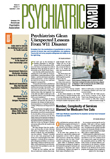Men with schizophrenia and a history of violence may have neurobiological signs that distinguish them from schizophrenia patients with no such history.
A review of studies comparing neurobiological correlates among persons with schizophrenia who do and do not have a history of violence found inconsistent and contradictory evidence—largely due to varying definitions of violence, differences in sample characteristics, and use of different measures to tap neurobiological correlates of violent behavior.
The findings suggest, however, that men with schizophrenia who have displayed a stable pattern of antisocial and aggressive behavior since childhood have some distinct signs compared with patients with no such history.
Those signs include reductions in amygdala volume, more structural abnormalities of the orbitofrontal system, more abnormalities of white matter in the amygdala-orbitofrontal system, and smaller reductions of volume in the hippocampus. Those men also appeared to perform better on neuropsychological tests tapping specific executive functions and more poorly on assessment of orbitofrontal functions.
The authors suggested that abnormalities in the amygdala-orbitofrontal system may be the neurological basis of persistent, impulsive antisocial and violent behavior.
“Persons with schizophrenia and a history of violence may present abnormalities in the amygdalae from early life that are associated with reduced abilities to experience emotions and to recognize emotions in others,” wrote Kris Naudts, M.D., and Sheilagh Hodgins, M.D., of the Department of Forensic Mental Health Science at the Institute of Psychiatry, King's College London, in the July Schizophrenia Bulletin. “As the individual matures, the connections with the orbitofrontal cortex do not develop.... In addition, abnormalities of the orbitofrontal cortext may be associated with difficulty in inhibiting impulsive decision making and behavior.”
They used Medline, PsycINFO, and Embase to identify studies of neuropsychological test performance, neurological soft signs, and structural and functional brain imaging of persons with schizophrenia and a history of violence.
Seventeen studies were identified. Because of differences in the definition of violence, sample characteristics, and measures used to identify neurobiological correlates, some of the findings are inconsistent and contradictory. But some findings do emerge from the review.
Six of nine studies looking at performance on neuropsychological tests indicate that patients with a history of violence perform better on these tests than patients without a similar history, suggesting fewer abnormalities of the prefrontal cortex. “This is reflected in better executive function and verbal skills, particularly in samples of outpatients with a history of violence,” the authors observed.
But impulsivity may stem from abnormalities in the orbitofrontal cortex, which Naudts and Hodgins said is necessary for inhibiting impulsive decision making and behavior and for anticipation of punishment or negative consequences.
“Persons with schizophrenia and a history of violence may present abnormalities in the amygdalae from early life that are associated with reduced abilities to experience emotions and to recognize emotions in others.”
In four studies that examined structural brain scans among men with schizophrenia who did and did not have a history of violence, the violent patients were distinguished by volume reductions in the amygdala and abnormalities in the orbitofrontal cortex-amygdala.
Two functional brain imaging studies also suggest differences among patients with a history of violence. Positron emission tomography brain scans of 17 patients who had a history of repetitive violent offending and 14 patients who had committed only one offense showed reduced activity in the anterior inferior temporal cortex of the left hemisphere in the repetitive-violent group.
A study using single photon emission tomography to assess the relationship between prefrontal function and aggression in 12 nonviolent patients and three violent patients found significantly reduced prefrontal cerebral blood flow during completion of the Wisconsin Card Sorting Test in the violent patients.
